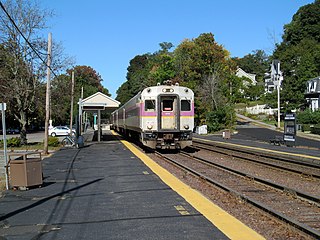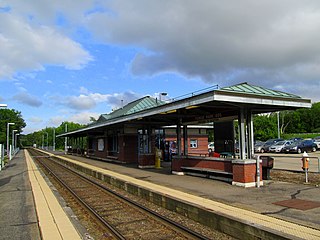
North Station is a commuter rail and intercity rail terminal station in Boston, Massachusetts. It is served by four MBTA Commuter Rail lines – the Fitchburg Line, Haverhill Line, Lowell Line, and Newburyport/Rockport Line – and the Amtrak Downeaster intercity service. The concourse is located under the TD Garden arena, with the platforms extending north towards drawbridges over the Charles River. The eponymous subway station, served by the Green Line and Orange Line, is connected to the concourse with an underground passageway.

The MBTA Commuter Rail system serves as the commuter rail arm of the Massachusetts Bay Transportation Authority's (MBTA's) transportation coverage of Greater Boston in the United States. Trains run over 394 mi (634 km) of track to 134 stations. It is operated under contract by Keolis, which took over operations on July 1, 2014, from the Massachusetts Bay Commuter Railroad Company (MBCR).

The Port of Boston is a major seaport located in Boston Harbor and adjacent to the City of Boston. It is the largest port in Massachusetts and one of the principal ports on the East Coast of the United States.
The Grand Junction Railroad is an 8.55-mile (13.76 km) long railroad in the Boston, Massachusetts, area, connecting the railroads heading west and north from Boston. The line is notable for its railroad bridge over the Charles River that passes under the Boston University Bridge between Boston and Cambridge, Massachusetts.

Sullivan Square station is a rapid transit station on the MBTA subway Orange Line, located adjacent to Sullivan Square in the Charlestown neighborhood of Boston, Massachusetts. It is a major transfer point for MBTA bus service, with 12 routes using a two-level busway. The station has two island platforms serving the two active Orange Line tracks plus an unused third track. The Haverhill Line and Newburyport/Rockport Line pass through the station on separate tracks but do not stop.

The Fairmount Line or Dorchester Branch is a line of the MBTA Commuter Rail system in Boston, Massachusetts, USA. Except for a short portion in Milton, it lies entirely within Boston, running southwest from South Station through the neighborhoods of Dorchester, Mattapan and Hyde Park. Weekend service began on November 29, 2014. Most trains reverse direction at the south end at Readville, but some Franklin/Foxboro Line trains use the Fairmount Line rather than the Northeast Corridor.

The Framingham/Worcester Line of the MBTA Commuter Rail system runs west from Boston, Massachusetts to Worcester, Massachusetts through the MetroWest region, serving 17 station stops in Boston, Newton, Wellesley, Natick, Framingham, Ashland, Southborough, Westborough, Grafton, and Worcester. It is the third longest and third busiest line in the MBTA Commuter Rail system. Service on the line is a mix of local and express trains serving Worcester plus short-turn Framingham locals.

The Fitchburg Line is a branch of the MBTA Commuter Rail system which runs from Boston's North Station to Wachusett station in Fitchburg, Massachusetts. The line is along the tracks of the former Fitchburg Railroad, which was built across northern Massachusetts, United States, in the 1840s. Winter weekend service includes a specially equipped seasonal "ski train" to Wachusett Mountain.

Braintree station is an intermodal transit station in Braintree, Massachusetts. It serves the MBTA's Red Line and the MBTA Commuter Rail Old Colony Lines as well as MBTA buses.

The Haverhill Line is a branch of the MBTA Commuter Rail system, running north from downtown Boston, Massachusetts through the cities and towns of Malden, Melrose, Wakefield, Reading, Wilmington, Andover, North Andover, Lawrence, and Haverhill.

Readville station is a Massachusetts Bay Transportation Authority (MBTA) commuter rail station located in the Readville section of the Hyde Park neighborhood of Boston, Massachusetts. It is served by the MBTA Commuter Rail Fairmount, Franklin/Foxboro, and Providence/Stoughton Lines. Readville is the outer terminus for most Fairmount service, though some trips continue as Franklin/Foxboro Line trains. The station is located at a multi-level junction, with the Attleboro Line tracks at ground level and the Dorchester Branch above; Franklin/Foxboro Line trains typically use a connecting track with a separate platform. An MBTA maintenance and storage yard and a CSX Transportation freight yard are located near the station.

Forge Park/495 station is a Massachusetts Bay Transportation Authority (MBTA) commuter rail station served by the Franklin/Foxboro Line. It is located off Route 140 near Interstate 495 in Franklin, Massachusetts, United States. A park and ride station serving southwestern Boston suburbs and northeastern Rhode Island, it is the outer terminus of the Franklin/Foxboro Line. The station has two side platforms serving a single track, with an accessible mini-high platform and a station building on the south platform.

Bellingham Square station is a Massachusetts Bay Transportation Authority (MBTA) Silver Line bus rapid transit (BRT) station located near Bellingham Square slightly north of downtown Chelsea, Massachusetts. The station has two accessible side platforms for buses on the SL3 route. The Boston and Maine Railroad and predecessor Eastern Railroad served Chelsea station at the same location from the mid-1850s to 1958. The MBTA opened Chelsea station on the Newburyport/Rockport Line in 1985. Prior to its 2010 cancellation, the Urban Ring Project planned for a circumferential BRT line with a stop at Mystic Mall. Planning continued for the Chelsea segment; a Silver Line extension to Mystic Mall was announced in 2013. Construction began in 2015, and SL3 service to the renamed Bellingham Square station began on April 21, 2018. Commuter rail service moved to the newly constructed Chelsea station on November 15, 2021.

Middleborough/Lakeville station is an MBTA Commuter Rail station in Lakeville, Massachusetts, just south of the Middleborough border. It is the southern terminus of the Middleborough/Lakeville Line; it is also an intermediate stop for seasonal CapeFlyer service to Cape Cod. Middleborough/Lakeville has a single full-length high-level side platform serving the line's single track.

Salem station is an MBTA Commuter Rail station served by the Newburyport/Rockport Line. The station is located off Bridge Street near its interchange with North Street at the north end of downtown Salem, Massachusetts. The station has a single accessible full-length high-level platform serving the single track of the Eastern Route. Just south of the station is the Salem Tunnel, which carries the line under Washington Street. Salem is a major park and ride center, with a 700-space parking garage, as well as an MBTA bus terminal. It is the busiest commuter rail station in the MBTA system outside of the central Boston stations, with an average of 2,326 daily boardings in a 2018 count.

Beacon Park Yard was a CSX Transportation rail yard in Allston, Boston, now owned by Harvard University. The yard opened in 1890 on the site of a former trotting park, from which it took its name. It was closed in 2013 following the relocation of the yard's container operations to Worcester, Massachusetts and opening of a transload facility in Westborough, Massachusetts. Plans for the yard include relocation of the Massachusetts Turnpike Allston exit, construction of a new MBTA commuter rail station and layover yard, and a major real estate development.

West Station is a planned station on the MBTA Commuter Rail Framingham/Worcester Line, to be located in the former Beacon Park Yard in Allston, Massachusetts. It was initially proposed as part of a project to straighten the Massachusetts Turnpike through the yard, allowing much of the land to be redeveloped. Initially to serve solely as a conventional commuter rail station, West Station is designed to eventually serve high-frequency diesel multiple unit service on the inner Worcester Line and on the Grand Junction Railroad.

Middleborough station is an under-construction MBTA Commuter Rail station in Middleborough, Massachusetts. It is expected to open in 2024 as part of the South Coast Rail project, replacing Middleborough/Lakeville station for regular service. The station will have a single side platform located inside the wye between the Middleborough Main Line and the Middleboro Secondary.

Chelsea station is a Massachusetts Bay Transportation Authority (MBTA) intermodal transit station located adjacent to the Mystic Mall in Chelsea, Massachusetts. It is the terminus of the SL3 route of the MBTA Silver Line bus rapid transit (BRT) network, and is served by the Newburyport/Rockport Line of the MBTA Commuter Rail. The accessible station has a loop with two small platforms for the Silver Line, and two full-length side platforms for commuter rail trains.

Eastern Avenue station is a bus rapid transit station on the Massachusetts Bay Transportation Authority (MBTA) Silver Line system, located in Chelsea, Massachusetts near Chelsea Creek. The accessible station has two side platforms, with street access from Eastern Avenue and Central Avenue. Plans for the Urban Ring Project called for a busway along the former Grand Junction Branch, but with a station further north at Griffin Way. After the Urban Ring was cancelled in 2010, new plans for a busway with an Eastern Avenue stop were announced in 2013. Construction began in 2015, with route SL3 service beginning on April 21, 2018.





















